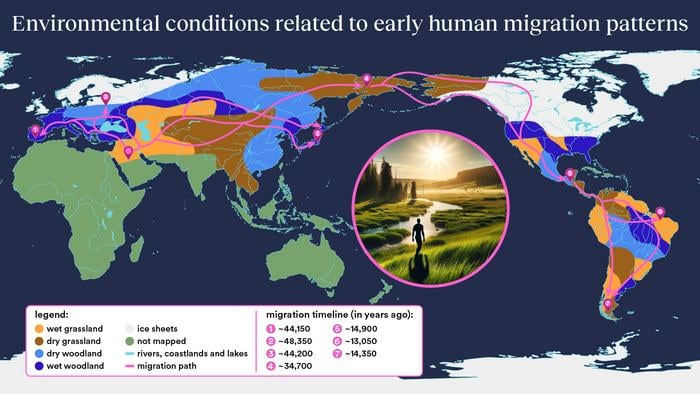The journey of early humans who ventured out of Africa more than 70,000 years ago was heavily influenced by the environmental conditions they encountered, according to a new study that combines climate models, genetic data, and archaeological evidence. The research, led by Dr Frédérik Saltré of Flinders University and published in Nature Communications, sheds light on how our ancestors navigated the diverse landscapes of northern Eurasia and the Americas.
The multidisciplinary analysis reveals that while the relative importance of environmental factors varied across regions, early humans primarily traveled through warm and humid areas containing a mix of forest and grasslands near rivers. These routes provided essential resources, shelter, and food, while allowing them to expand into new territories.
Tracing the Path of Early Migrants
In Europe, the first human migrants likely spread from the Fertile Crescent through the Caucasus Mountains into Scandinavia around 48,300 years ago and Western Europe around 44,100 years ago, following warmer and wetter conditions. In northern Asia, migration routes followed major rivers to cope with harsher climates before reaching Beringia, a currently submerged land bridge between Siberia and Alaska, approximately 34,700 years ago.
In North America, humans initially migrated along the Pacific coast around 16,000 years ago, and then approximately 3000 years later, moved inland through the ice-free corridor by the Mackenzie River. In South America, migration followed wetter grasslands bordering the Amazon, leveraging connectivity provided by major rivers by 14,800 years ago.
Insights from Modelling and Interdisciplinary Collaboration
Professor Tom Higham of the University of Vienna highlighted the exciting potential of these new modelling approaches in understanding the deep human past. “Incorporating new modelling methods with the latest climatic, archaeological, and environmental data allows really exciting insights into understanding how ancient humans moved and adapted across vast continents tens of thousands of years ago,” he said.
Professor Corey Bradshaw of Flinders University and a Chief Investigator at CABAH emphasized the power of modelling in exploring the complexities of deep history and understanding how past events and conditions have shaped the present. “Knowing where people first trekked beyond the cradle of human evolution gives us a flavour of how adaptable our early ancestors were, what environmental challenges they faced, and how they overcame them and survived,” he said.
Associate Professor Bastien Llamas from The University of Adelaide and a Deputy Director in CABAH noted that merging genetic data with historical climate information and archaeological discoveries is a powerful method for inferring past human migration patterns. “Studying genetic differences between groups of people helps us understand ancient migration patterns,” he explained.
Dr Saltré emphasized the importance of biodiversity in how our ancestors adapted to and overcame environmental challenges. “It underscores how climate and ecology shaped human prehistory, highlighting biodiversity’s role in human survival and mobility, demonstrating that rich ecosystems enabled humans to thrive in new environments for thousands of years,” he said. “The biodiversity crisis that we are experiencing now compromises our ability to thrive. Despite the advanced technology we have today, I genuinely wonder if we will last long without maintaining the bulk of current biodiversity.”
If our reporting has informed or inspired you, please consider making a donation. Every contribution, no matter the size, empowers us to continue delivering accurate, engaging, and trustworthy science and medical news. Independent journalism requires time, effort, and resources—your support ensures we can keep uncovering the stories that matter most to you.
Join us in making knowledge accessible and impactful. Thank you for standing with us!

